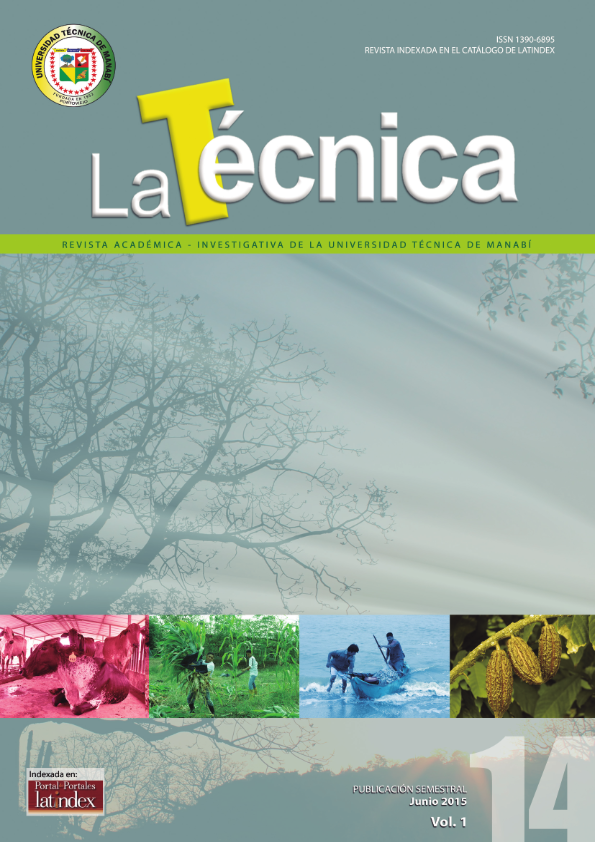Determinación del Índice de Importancia Relativa en Oreochromis sp cultivadas con biofloc y alimento balanceado
Determination of the Relative Importance Ratings in cultivated Oreochromis sp with biofloc and feed
DOI:
https://doi.org/10.33936/la_tecnica.v0i14.583Palabras clave:
Flóculos, Tecnología Biofloc, IIR, cultivo de tilapia, producción acuícolaResumen
El objetivo de este estudio fue determinar el Índice de Importancia Relativa en tilapias (Oreochromis sp) cultivadas con biofloc y alimento balanceado, con el fin de identificar que fuente alimenticia era consumida de manera preferente por estos peces. Para ello se analizaron los estómagos de tilapias tras haber sido alimentadas con balanceado. Los resultados mostraron que las tilapias utilizaron como fuente de consumo principal el biofloc, constituyéndose como un factor sustentador de la vida de estos individuos cultivados. El alimento balanceado se presentó como fuente secundaria de alimentación, mostrándose también como un sustento necesario para garantizar el desarrollo óptimo del biofloc.
Palabras clave: Flóculos, Tecnología Biofloc, IIR, cultivo de tilapia, producción acuícola.Descargas
Citas
Carbo, J., Celades, L. 2011. Ensayos preliminares de engorde de Tenca (Tinca tinca) con Tecnología de Biofloc. Consultado el 12 de febrero del
2015: http://www.recercat.cat/bitstream/handle/2072/179057/P-175-Carb%C3%B3R. pdf?sequence=36
Chamberlain, G., Avnimelech, Y., McIntosh, R.P. & Velasco, M. 2001. Advantages of aerated microbial reuse systems with balanced C:N. II: Composition and nutritional value of organic detritus, The Global Aquaculture Advocate, 11: 22-24.
Charles Olaya-Nieto,* M.Sc, Pedro Soto- Fernández, Acuicult, Javier Barrera-Chica, Acuicult. (2009). Hhabitus alimentations de la mayupa (sternopygus macrurus bloch & schneider, 1801) en el río sinú, Colombia. Recuperado el agosto de 2014, de http:// www.scielo.org.co/scielo.php?pid=S0122- 02682009000300002&script=sci_arttext
De Schryver, P, Crab, R, Defoirdt, T, Boon, N, Verstraete, W. (2008), The basics of biofloc technology: the added value of aquaculture. Aquaculture; 277: 125-137
Ekasari J., R. Crab and W. Verstraete. 2010. Primary Nutritional Content of Bio-flocs Cultured with Different Organic Carbon Sources and Salinity. HAYATI Journal of Biosciences 17(3):125-130.
Emerciano, M, Ballester, E, Cavalli, R, Wasielesky, W. (2012), Biofloc technology application as a food source in a limited water exchange nursery system for pink shrimp Farfantepenaeus brasiliensis. Aquacult. Res. (43): 447-457.
Ghanekar, A. (2009). How biofloc technology reduces feed and filtration costs in recirculated shrimp nursery systems. Aquacult Asia Pacific 5 (3): 72 –74.
Newman, S, (2011), Understanding biofloc in aquaculture production systems. Aquaculture Asia Pacific Magazine, 7 (2): 25-26.
Hargreaves, D. J. (Abril de 2013). Biofloc Production Systems for Aquaculture. Recuperado el 2 de Agosto de 2014, de https:// srac.tamu.edu/index.cfm/event/getFactSheet/ whichfactsheet/259/
Jorand, F., Zartarian, F., Thomas, F., Block, J.C., Bottero, J.Y., Villemin, G., Urbain, V., Manem, J., 1995. Chemical and structural (2d) linkage between bacteria within activated-sludge flocs. Water Res. 29 (7), 1639–1647Bardach, R; K, Lagler ;R, Miller; D, Pacino. 1990. AGT Editores S.A. 480 paginas.
Krummenauer, D., Seif ert, C.A., Poersch, L.H., Kipper Foes, G., Rodríguez De Lara, G., Wasielesky, W.(2012). Cultivo de camaroes marinhos em sistema de bioflocos:analise da reutilizacao da agua. Universidade Federal do Rio Grande. Rio Grande, Atlantica 34 (2): 103-111.
Kuznicki, L., E. Mikolajczyk, and P. L. Walne. 1990. Photobehavior of euglenoid flagellates: theoretical and evolutionary perspectives. Plant Sci. 9:343-369.
LAEVASTU T. Manual de métodos de biología pesquera. Zaragoza: Editorial Acribia; 1980.
LAGLER, K.F.; J.E. BARDACH; R.R. MILLER y D.R.M. PASSINO. 1990. Ictiología. AGT Edit. México. 489 p.
Marrero C. Métodos para cuantificar contenidos estomacales en peces. Universidad Nacional Experimental de Los Llanos Ezequiel Zamora- Unellez, Vicerrectorado de Producción Agrícola, Programa de Recursos Naturales Renovables, Museo de Zoología, Guanare; 1994.
Ray, J, Dillon, K, Lotz, J. (2011). Water quality dynamics and shrimp Litopenaeus vannamei) production in intensive mesohaline culture systems with two levels of biofloc management. Aquacult. Eng. 45: 127 -136.
Salehizadeh, H., Van Loosdrecht, M.C.M., 2004. Production of polyhydroxyalkanoates by mixed culture: recent trends and biotechnological importance. Biotechnology Advances. 22:261–279.
Shiau S.Y. 1997. Utilization of carbohydrates in warm water fish-with particular references to tilapia Oreochromis niloticus x O. aureus. Aquaculture
151: 79-96.























